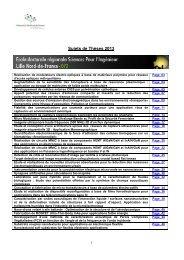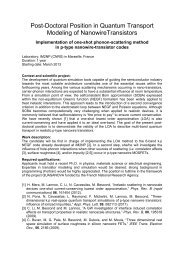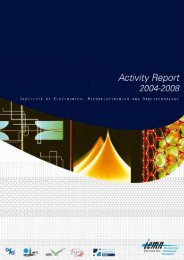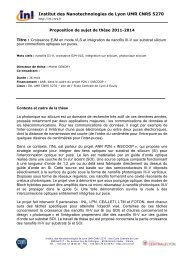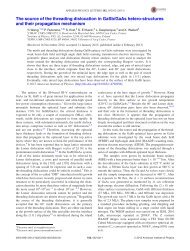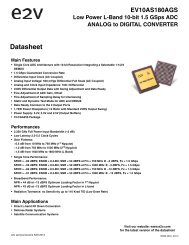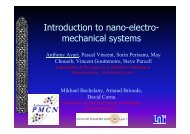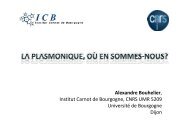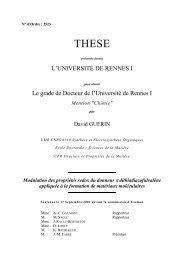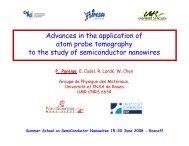Multiple scattering effects in strain and composition analysis ... - IEMN
Multiple scattering effects in strain and composition analysis ... - IEMN
Multiple scattering effects in strain and composition analysis ... - IEMN
You also want an ePaper? Increase the reach of your titles
YUMPU automatically turns print PDFs into web optimized ePapers that Google loves.
013112-3 Richard et al. Appl. Phys. Lett. 94, 013112 2009<br />
Ge content<br />
1<br />
α<br />
0.8<br />
i<br />
=0.12°<br />
<br />
α i<br />
=0.2°<br />
<br />
<br />
<br />
0.6<br />
<br />
<br />
<br />
<br />
<br />
<br />
<br />
<br />
<br />
<br />
<br />
<br />
<br />
<br />
<br />
<br />
<br />
<br />
0.4<br />
<br />
<br />
<br />
<br />
0.2<br />
<br />
<br />
<br />
<br />
<br />
<br />
0<br />
3.9 3.92 3.94 3.96 3.98<br />
h (r.l.u.)<br />
FIG. 3. Color onl<strong>in</strong>e Ge content as a function of h as extracted us<strong>in</strong>g<br />
graz<strong>in</strong>g <strong>in</strong>cidence MAD with 12 different energies around the Ge K-edge.<br />
The Ge content extracted for two different <strong>in</strong>cident angles rema<strong>in</strong>s consistent<br />
<strong>in</strong> spite of the strong Ih dependence with i .<br />
tical functions, which are energy <strong>in</strong>dependent far from c <strong>in</strong><br />
the case of a buffer conta<strong>in</strong><strong>in</strong>g nonanomalous atoms. Therefore<br />
dur<strong>in</strong>g a MAD experiment the extracted structure factors<br />
are F Ge <strong>and</strong> F Si multiplied by these functions. S<strong>in</strong>ce the Ge<br />
<strong>composition</strong> is extracted by a ratio of these factors accord<strong>in</strong>g<br />
to x Ge = f Si F Ge /f 0 0<br />
Ge F Si + f Si F Ge , where f Ge <strong>and</strong> f Si are the<br />
Ge Thomson atomic form factor <strong>and</strong> the Si atomic form factor,<br />
respectively, the generalized optical functions disappear<br />
from the result, <strong>and</strong> the deduced <strong>composition</strong> is not affected<br />
by multiple <strong>scatter<strong>in</strong>g</strong> <strong>effects</strong>. This result was experimentally<br />
checked by compar<strong>in</strong>g the results of graz<strong>in</strong>g-<strong>in</strong>cidence MAD<br />
<strong>analysis</strong> of the dome sample for different <strong>in</strong>cident angles.<br />
Figure 3 shows the Ge <strong>composition</strong> calculated from the Ge<br />
<strong>and</strong> Si structure factors F Si <strong>and</strong> F Ge , which were extracted<br />
for two <strong>in</strong>cident angles without any structural hypothesis,<br />
<strong>and</strong> ref<strong>in</strong>ed through a least-squares m<strong>in</strong>imization us<strong>in</strong>g<br />
a dedicated program. 12 This program evaluates the uncerta<strong>in</strong>ties<br />
of F Ge <strong>and</strong> F Si <strong>and</strong> hence the error bars on the Ge<br />
<strong>composition</strong>. The partial structure factors are affected by the<br />
generalized optical function as is the total <strong>scatter<strong>in</strong>g</strong> amplitude.<br />
However, only slight variations <strong>in</strong> the Ge <strong>composition</strong><br />
are observed, with overlapp<strong>in</strong>g error bars. Hence, the correct<br />
Ge content is extracted, whatever the conditions of <strong>in</strong>cidence.<br />
A BA treatment of anomalous diffraction can thus be<br />
performed to extract the <strong>composition</strong> of isostra<strong>in</strong> regions of<br />
the isl<strong>and</strong>s. The subcritical regime i c yields smaller<br />
<strong>scatter<strong>in</strong>g</strong> from the substrate <strong>and</strong> is thus preferred.<br />
To conclude, for large isl<strong>and</strong>s, multiple <strong>scatter<strong>in</strong>g</strong> <strong>effects</strong><br />
strongly distort the <strong>in</strong>tensity distribution <strong>in</strong> reciprocal space<br />
<strong>and</strong> need a complete DWBA <strong>analysis</strong> to extract the lattice<br />
parameter distribution. By contrast, the <strong>in</strong>-plane stra<strong>in</strong> <strong>in</strong><br />
small isl<strong>and</strong>s can be <strong>in</strong>vestigated us<strong>in</strong>g a BA treatment.<br />
Hence, <strong>scatter<strong>in</strong>g</strong> from small <strong>and</strong> large isl<strong>and</strong>s can be dist<strong>in</strong>guished<br />
simply by vary<strong>in</strong>g the <strong>in</strong>cident angle around the<br />
critical angle c , check<strong>in</strong>g if the <strong>in</strong>tensities can be superimposed<br />
to each other by rescal<strong>in</strong>g. This may be most useful for<br />
bimodal isl<strong>and</strong> growth e.g., pyramids <strong>and</strong> domes <strong>in</strong> the<br />
Ge/Si case to discrim<strong>in</strong>ate the orig<strong>in</strong> of the measured <strong>in</strong>tensity.<br />
Most importantly, the st<strong>and</strong>ard MAD <strong>analysis</strong> can be<br />
applied to all isl<strong>and</strong>s as long as the x-ray energy is far from<br />
an absorption edge of the substrate <strong>and</strong> the substrate does not<br />
conta<strong>in</strong> any elements violat<strong>in</strong>g this condition.<br />
Z.Z. acknowledges support from the FWF, Vienna. We<br />
acknowledge Hubert Renevier for fruitful discussions.<br />
1 J. Stangl, V. Holý, <strong>and</strong> G. Bauer, Rev. Mod. Phys. 76, 7252004.<br />
2 A. Létoublon, V. Favre-Nicol<strong>in</strong>, H. Renevier, M. G. Proietti, C. Monat, M.<br />
Gendry, O. Marty, <strong>and</strong> C. Priester, Phys. Rev. Lett. 92, 186101 2004.<br />
3 I. Kegel, T.-H. Metzger, A. Lorke, J. Peisl, J. Stangl, G. Bauer, J. M.<br />
Garcia, <strong>and</strong> P. Petroff, Phys. Rev. Lett. 85, 1694 2000.<br />
4 T. U. Schülli, J. Stangl, Z. Zhong, R. T. Lechner, M. Sztucki, T. H.<br />
Metzger, <strong>and</strong> G. Bauer, Phys. Rev. Lett. 90, 066105 2003; T. U. Schülli,<br />
M. Stoffel, J. Stangl, R. T. Lechner, E. W<strong>in</strong>tersberger, M. Sztucki, T. H.<br />
Metzger, O. G. Schmidt, <strong>and</strong> G. Bauer, Phys. Rev. B 71, 035326 2005.<br />
5 A. Malachias, S. Kycia, G. Medeiros-Ribeiro, R. Magalhães-Paniago, T. I.<br />
Kam<strong>in</strong>s, <strong>and</strong> R. Stanley Williams, Phys. Rev. Lett. 91, 176101 2003.<br />
6 M. Schmidbauer, D. Grigoriev, M. Hanke, P. Schafer, T. Wiebach, <strong>and</strong> R.<br />
Kohler, Phys. Rev. B 71, 115324 2005.<br />
7 I. N. Stranski <strong>and</strong> L. Krastanow Sitzungsber. Akad. Wiss. Wien, Math.-<br />
Naturwiss. Kl., Abt. 2B 146, 797 1938.<br />
8 M. Rauscher, R. Paniago, H. Metzger, Z. Kovats, J. Domke, H. D.<br />
Pfannes, J. Schulze, <strong>and</strong> I. Eisele, J. Appl. Phys. 86, 6763 1999.<br />
9 J. Coraux, V. Favre-Nicol<strong>in</strong>, M. G. Proietti, B. Daud<strong>in</strong>, <strong>and</strong> H. Renevier,<br />
Phys. Rev. B 75, 235312 2007.<br />
10 V. Ranjan, G. Allan, C. Priester, <strong>and</strong> C. Delerue, Phys. Rev. B 68, 115305<br />
2003.<br />
11 I. Kegel, T.-H. Metzger, A. Lorke, J. Peisl, J. Stangl, G. Bauer, K. Nordlund,<br />
W. V. Schoenfeld, <strong>and</strong> P. Petroff, Phys. Rev. B 63, 035318 2001.<br />
12 V. Favre-Nicol<strong>in</strong>, <strong>in</strong> preparation.



